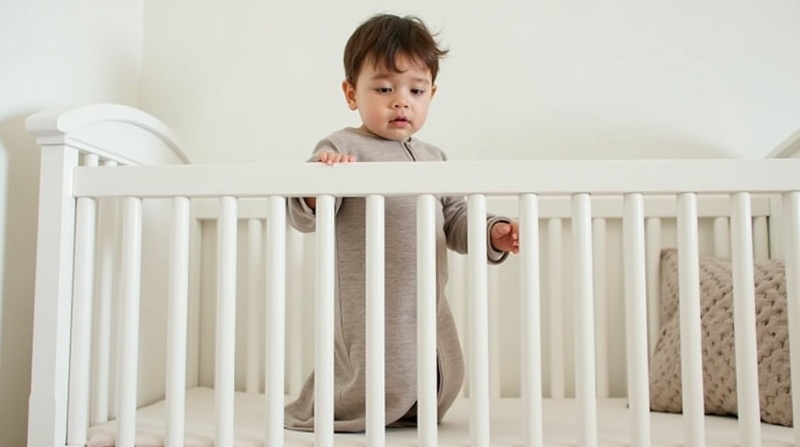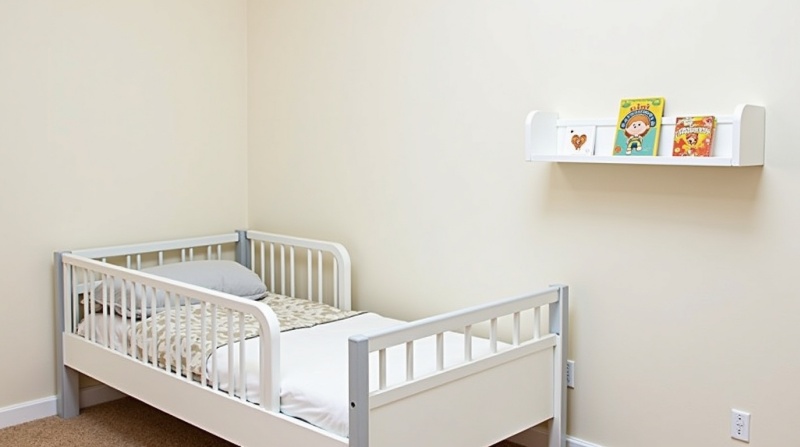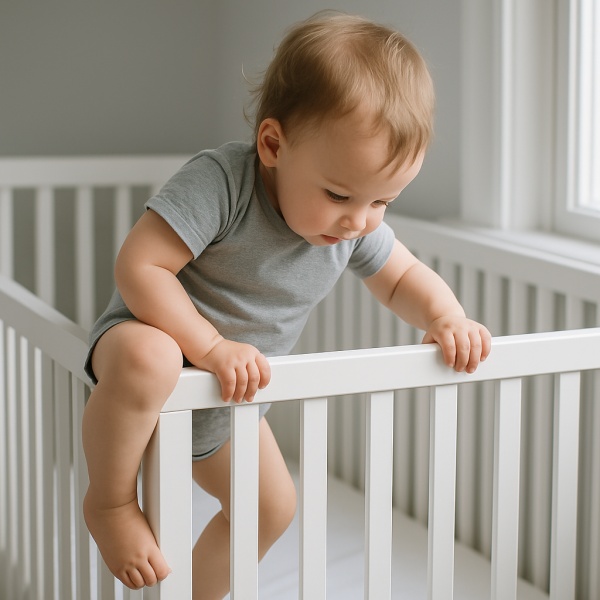There’s a particular sound that sends a jolt of pure adrenaline straight to a parent’s heart— It’s the quiet, ominous thump of little feet hitting the floor, followed by the sudden, unexpected appearance of your toddler in the hallway—a toddler you just lovingly tucked into their crib.
This moment isn’t about a child being “bad” or defiant; it’s about a natural developmental leap meeting a physical obstacle. Your toddler is simply solving a problem: they want to be with you, and they’ve figured out how to get there.
Should we lower the mattress, or is it time to switch to a big-kid bed right now? Don’t worry—we’re here to help you navigate this transition with confidence. In this article, we’ll walk you through practical steps to keep your little explorer safe.
At What Age Do Toddlers Climb Out of the Crib?
Most toddlers begin testing their climbing abilities at 18 and 24 months of age.
This is a period of explosive physical development where toddlers are mastering climbing on furniture, stairs, and anything else they can find. It’s also a time of intense cognitive growth, where they begin to understand how to use objects as tools and sequence actions together to achieve a goal—like stacking blankets to create a step or maneuvering their body in just the right way to swing a leg over the rail.
The most reliable sign that climbing is imminent has less to do with age and more to do with height. When the crib rail is less than three-quarters of the way up your child’s chest, it crosses a dangerous red line. Please always focus on this safety standard, not the age number. This is our non-negotiable standard for safety.
Why Is My Toddler Climbing Out of the Crib?
A child’s decision to climb out is usually a mix of these four factors. Understanding them helps you respond with calmness, not punishment.
Physical Growth & Height: This is the main reason. They are taller, and their muscle strength lets them pull themselves over easily. Your child is just using their new skills!
A Quest for Independence: Toddlers are learning to control their world. Climbing out is an instinctive expression of their need to “do it myself.” They want control over where they go.
Environmental Issues: Maybe the mattress is too high, or there are too many toys in the crib that act as stepping stones. Sometimes, just waking up at night and feeling bored is enough for them to want to come out and find you.
Emotional Factors or Sleep Regression: When a child goes through sleep regression or separation anxiety, they might try to escape to be close to a parent for comfort. In this case, we should first address the underlying emotional need.
What Are the Best Ways to Stop Crib Climbing Safely?

When you notice your child trying to climb, you need to take immediate action. Your top job is to remove safety risks from the room. These steps will make the crib harder to escape and help you, the parent, feel more secure.
Lower the Mattress to the Absolute Lowest Setting
We can’t stress how important this is. This is the first and most critical physical step you can take. If your mattress isn’t on the lowest setting, you are giving your child an extra boost. Please check and adjust it right away. You must make sure the rail height is well above their chest when they stand.
To make safe, easy mattress height adjustments, you need a well-designed crib. Professional baby crib manufacturers, such as Clafbebe, understand that usability and safety are vital for parents.
Remove All Potential “Stepping Stones
Kids are smart. They will use anything in the crib to gain an advantage for climbing. You need to make the crib a bare sleeping space. This means removing:
- All stuffed toys or dolls.
- Crib bumpers or pads.
- Any thick blankets or pillows.
The goal is to eliminate any spot inside the crib where your child’s foot or knee could get a solid grip.
The Sleep Sack/Footed PJ Strategy
The sleep sack is a safety-approved sleep aid that limits your child’s ability to lift their legs high enough to cross the rail. If you use a sleep sack for your toddler, try putting it on backwards with the zipper facing the back. It sounds a little strange, but this prevents them from unzipping it themselves and effectively limits their movement. This strategy works hand-in-hand with your lowest mattress setting to significantly increase the difficulty of climbing.
The Power of Calm and Consistency
Your child climbing out of the crib can be a way to seek your reaction. If you overreact—whether by getting angry, laughing, or giving too much attention—you are accidentally rewarding the behavior. When they climb out, you should maintain a calm, neutral tone. Immediately and quietly return your child to the crib, repeating a simple, neutral phrase like, “It’s time for sleep.” Consistency is key here.
Ensure the Room is Fully Childproofed
If your child manages to escape the crib, you must make sure their bedroom is 100% safe. This is not just about preventing falls, but also about preventing them from wandering while you are asleep.
- Furniture Anchoring is the Baseline: This is a must-do! Secure all tall or heavy furniture, such as dressers and bookshelves, to the wall to prevent tip-overs.
- Use Outlet Covers.
- Install a child safety gate or a high-placed lock on the bedroom door to stop them from leaving the room at night.
What Common Mistakes Should You Avoid?
In trying to solve the climbing problem, sometimes parents react in ways that can make the issue worse. To avoid extending this challenging phase, make sure you are not making these three common mistakes:
Do Not Switch Beds Too Early
We know you might want to switch your child to a toddler bed right away to “solve” the problem. But unless there is a clear safety red line (which we will discuss next), switching too early often creates more problems than it solves. A toddler bed brings freedom, and many toddlers are not ready for this freedom. This can lead to worse sleep issues, like wandering and confusing routines. Try all crib safety steps first.
Do Not Remove the Crib from the Room
If your child keeps climbing out, you might feel like you should just remove the crib entirely. However, suddenly taking away a sleep tool the child is used to can confuse their understanding of sleep and space. This can cause unnecessary anxiety and make the transition to a new bed harder.
Do Not Overreact or Punish
Remember that climbing is a developmental instinct, not intentionally bad behavior. Overreacting, scolding, or punishing can bring shame and may cause them to link bedtime with bad feelings. Your goal is to safely stop the action, not punish the child themselves.
When Must You Switch to a Toddler Bed?

The one and non-negotiable “must switch” signal is the safety red line: If your child reaches a height of 35 inches (about 89 cm) or if the rail is below their chest when they stand up.
Once this standard is reached, the risk of falling is too high, no matter how many steps you take. At this point, the crib is no longer a safe sleep space, and you should immediately move to a safer toddler or floor bed.
Besides the height red line, you need to check your child’s thinking ability:
- Can they understand and follow simple rules? (Like: “You must stay in bed until the birds sing.”)
- Do they understand the concept of “boundaries”? (Like: knowing not to play with outlets or climb cabinets.)
If the answer is yes, they might be ready for the transition, even if they are slightly shorter.
The Crib Escape Assessment Checklist
Judging solely by height is not enough. We offer this unique scoring checklist to help you assess your child’s behavioral readiness across three dimensions: physical, emotional, and cognitive. Please score based on your child’s reality (a total score over 10 points strongly suggests a transition).
| Dimension | Behavioral Sign | Score |
| Physical | Can reliably and effortlessly flip over the rail. | +5 Points |
| The rail is below their armpit when standing, even with the mattress lowered. | +4 Points | |
| Cognitive | Can understand and follow simple two-step commands. | +3 Points |
| Can clearly express needs, e.g., “diaper,” “water,” “hug.” | +2 Points | |
| Emotional | Shows intense separation anxiety or night fears. | -2 Points |
| Can play quietly for 10+ minutes and has self-soothing skills. | +1 Point |
Assessment Conclusion: If your child’s total score is over 10 points, do not wait any longer. You should immediately focus on fully childproofing the room for a new sleep environment. If the score is lower, try all the immediate safety steps suggested earlier in this guide first.
Comparison Table: Crib vs. Toddler Bed vs. Floor Bed
Choosing a new sleep setup can be confusing. The table below clearly compares the pros and cons of the three common transition options:
| Feature | Crib | Toddler Bed | Floor Bed |
| Safety | Highest (Highest rails) | High (Low to the floor, usually with rails) | Medium (Free movement; requires full room childproofing) |
| Fostering Independence | Lowest | Medium (Limited freedom) | Highest (Child controls their sleep) |
| Longevity | Shortest (Up to 35-inch red line) | Short (Usually only until 4-5 years old) | Long (Can use a twin-size mattress) |
| Parent Convenience | Higher (Keeps child contained) | Medium (Child might leave the bed at night) | Lowest (May need to be comforted on the floor; high child freedom) |
How to Childproof the Room for a Big-Kid Bed?
Once you make the decision to switch, you need to change your focus from “climb-proofing” to “escape-proofing” and “accident-proofing.”
When children gain freedom of movement, they will explore every corner of the room. You must do a complete safety check again:
- Furniture Anchoring is the Baseline: Stress again that all furniture must be fixed to the wall using anti-tip straps.
- Cords and Blinds: Remove or shorten all cords so they are out of reach.
- Install a safety lock or safety gate on the bedroom door to stop them from leaving the room and accessing unsafe areas like the kitchen or stairs at night.
Even with a low toddler bed, children may still roll out while sleeping, so using removable bed rails or placing one side of the bed against the wall can help prevent falls. At the same time, let your child help choose new bedding (like a sheet or pillow). This helps them feel positive about the new bed and gives them a sense of ownership.
The transition requires stability, so avoid giving too much sleep freedom all at once. Continue to keep all the routines you used with the crib, including story time, songs, and timing. Do not change the sleep schedule and the sleep location at the same time.
Conclusion
Your child climbing out of the crib is a worrying but normal stage of development. As a parent, your top job is always safety. Please lower the crib mattress immediately, remove all stepping stones, and stay calm and consistent in your reaction. Only when you reach the 35-inch height red line is it time to consider switching.
Please trust that professional manufacturers, such as Clafbebe, always stick to safety and structural stability as their core design values. By choosing products focused on adjustability and sturdiness, you provide the most reliable security for your child’s safe development.
Recommended Related Articles:
- How to Convert a Crib to a Toddler Bed?
- What Is a Mini Crib? A Complete Guide
- Are Cribs with Changing Tables Worth It? Complete Parent’s Guide
- 7 Best Convertible Cribs That Grow with Your Baby (2025)
- Are Drop-Side Cribs Safe? What Parents Need to Know
- Crib Recalls 2025: What Parents Need to Know
- Are Crib Bumpers Safe? Latest Pediatric Guidelines
- Crib Alternatives: What Can a Baby Sleep in Besides a Crib?
- Mini Crib Vs Crib: Which Is Best for Your Baby?
- Crib Safety Checklist: A Guide for New Parents













